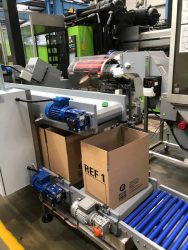

|
Edward Lowton
Editor |


|
| Home> | Handling and Storing | >Conveyors | >Unattended production achieved |
Unattended production achieved
23 July 2018
UPM Conveyors recently worked on updating the production system for Oakham-based Rutland Plastics which operates 150 to1700t moulding machines.

Rutland Plastics wanted to achieve unattended production on a Krauss Maffei KM150. UPM provided a turnkey solution using eight belt conveyors to allow automatic product divert for QC inspection; ferrous/non-ferrous metal detection; product cooling; parts separation and box filling with a capacity of eight full; eight empty and one filling.
Product divert is achieved with a small reversing conveyor located onto a swan neck conveyor in the well of the machine and at any stage in production an operator can energise to reverse and transfer a shot to an integral sample drawer for QC inspection.
Metal detection is based on UPM inserting a search coil under the inclined section of the Swan Neck in the well of the machine. When a foreign body is detected it will energise an audio-visual alarm and stop the belt conveyor, allowing an operator to check and remove the contamination.
This process does not affect the moulding machine cycle; products continue to be produced and accumulated on the conveyor until the operator has reset to start again.
Further automated elements
Product cooling is necessary to avoid any deformation to the mouldings which are produced in PP on multi-cavity tools ranging from 8-16 impressions mould and four sprues with a section thickness of 5 to 15mm. UPM fitted a cooling tunnel with high flow air fans to reduce the temperature from 80 to 20°C.
For parts separation, the system works via a roller drum with central adjustment for the gap to allow ease of changing so the sprues exit onto another swan neck for transfer to a granulator and mouldings discharge. This then goes to a third swan neck for conveying to the box filling station.
The box filling station by UPM is a two tier construction and was designed to accommodate eight full boxes; eight empty and one filling with the box located onto a weigh scale to count by weight which achieves a high level of accuracy.
On achieving the correct pre-weight/count the overhead conveyor will stop; the full box is indexed off and an empty box brought onto the weight scale which initiates the overhead conveyor to start again repeating the cycle. When all boxes are full, a sensor will energise an audible /visual alarm to alert an operator.
The central control is a PLC controlling all aspects of the system interfacing with the variable speed drives on each conveyor and connecting to the weigh scale.
- Handling for moulding machine
- Tote box filler for unattended production
- Versatile handling
- Bespoke solution cuts component loss
- Performance guaranteed
- Total versatility
- Increased capacity
- Handling food requirements
- UPM - Another successful bespoke project with Lenham Storage
- Conveyor firm expands to meet demand

















